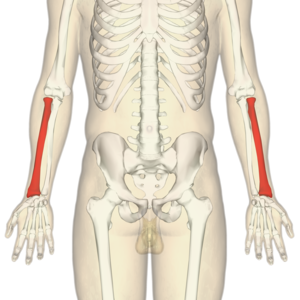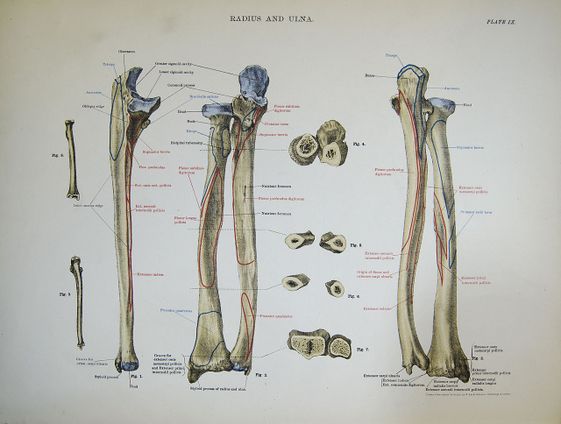Description
The radius is one of the two bones that make up the forearm, the other being the ulna. It forms the radio-carpel joint at the wrist and the radio-ulnar joint at the elbow. It is in the lateral forearm when in the anatomical position. It is the smaller of the two bones.
Structure
Proximal radius
The proximal radius consists of the radial head, neck and tuberosity.
The radial head is cylindrical which articulates with the capitellum of the humerus[1]. The head rotates within the annular ligament to produce supination and pronation of the forearm.[2]
The neck and tuberostiy support the head and provide points of attachments for supinator brevis and biceps bracii.[1]
Radial shaft
The shaft of the radius is slightly curved into convex from the body. The majority of the shaft has three borders: anterior, posterior and interosseous.
Distal radius[2]
The distal radius has five surfaces:
- Lateral – which extends to form the styloid process
- Medial – consists of a concave ulnar notch to articulate with the ulnar head in pronation
- Posterior – convex and contains a prominent ridge called Lister’s tubercle
- Anterior – smooth and forms a distinct margin
- Distal articular surface – articulates laterally with scaphoid and medially with lunate
Function
The radius’ main functions are to articulate with the ulna and humerus at the elbow to provide supination and pronation. Then to articulate with the lunate and scaphoid to provide all the movements of the wrist.
Articulations
Elbow
The radius articulates with the ulna in a synovial pivot joint. The radial head rotates within the annular ligament and radial notch on the ulna to produce pronation of the forearm.[3]
The radius and ulna also articulate distally in reverse to their articulation at the elbow to produce supination. This movement occurs with the head of the ulna being received into the ulnar notch of the radius. [3]
Wrist
The radius articulates with the first row of carpel bones: mainly scaphoid laterally and the lunate medially to form the radio-carpel joint, triquetral only makes intermittent contact on ulnar abduction. The radio-carpel joint is an ellipsoid joint whereby the scaphoid, lunate and triquetral bones form a convex surface to articulate with the distal radius’ concavity.
The radio-carpel joint has four movements: flexion, extension, radial and ulnar deviation.
Muscle attachments
Proximal
Biceps bracii attaches to the radial tuberosity.
Supinator, flexor pollicis longus and the flexor digitorum superficialis attach to the upper third part of the shaft of the radius.
Mid shaft
Extensor pollicis brevis muscle, abductor pollicis longus muscle, and pronator teres all attach to the mid shaft of the radius
Distal
Pronator quadratus muscle and the tendon of the supinator longus attach to the distal quarter of the radial shaft.
Clinical relevance
Colles fracture: is a fracture of the distal radius. Commonly caused by a fall on outstretched hand (FOOSH)
Radial head fracture: commonly caused from FOOSH this can be accompanied by dislocation of the radius and/or ulna which can complicate the management of this injury.[5]
Osteoarthritis of the wrist or elbow
Radial dysplasia or radial club hand can occur in paediatric patients as a congenital condition whereby there is a shortening of the radius or even complete lack of radius in the forearm. This can lead to thumb abnormalities and the need for surgical intervention to improve function.[6]
Resources
Ola!
Como podemos ajudar?



